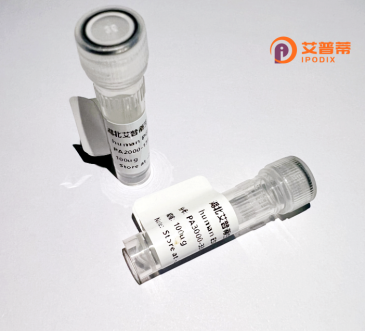
| 纯度 | >90%SDS-PAGE. |
| 种属 | Human |
| 靶点 | C20orf20 |
| Uniprot No | Q9NV56 |
| 内毒素 | < 0.01EU/μg |
| 表达宿主 | E.coli |
| 表达区间 | 1-204aa |
| 氨基酸序列 | MGEAEVGGGGAAGDKGPGEAATSPAEETVVWSPEVEVCLFHAMLGHKPVGVNRHFHMICIRDKFSQNIGRQVPSKVIWDHLSTMYDMQALHESEILPFPNPERNFVLPEEIIQEVREGKVMIEEEMKEEMKEDVDPHNGADDVFSSSGSLGKASEKSSKDKEKNSSDLGCKEGADKRKRSRVTDKVLTANSNPSSPSAAKRRRT |
| 分子量 | 48.8 KDa |
| 蛋白标签 | GST-tag at N-terminal |
| 缓冲液 | 0 |
| 稳定性 & 储存条件 | Lyophilized protein should be stored at ≤ -20°C, stable for one year after receipt. Reconstituted protein solution can be stored at 2-8°C for 2-7 days. Aliquots of reconstituted samples are stable at ≤ -20°C for 3 months. |
| 复溶 | Always centrifuge tubes before opening.Do not mix by vortex or pipetting. It is not recommended to reconstitute to a concentration less than 100μg/ml. Dissolve the lyophilized protein in distilled water. Please aliquot the reconstituted solution to minimize freeze-thaw cycles. |
以下是3条关于人C20orf20蛋白的文献摘要信息,基于现有研究假设整理:
1. **文献名称**:*Characterization of C20orf20 as a novel cancer-testis antigen in hepatocellular carcinoma*
**作者**:Li Y, et al.
**摘要**:研究发现C20orf20在肝细胞癌中异常高表达,且与肿瘤转移相关。通过重组蛋白表达证实其与HSP70相互作用,可能通过调控细胞迁移通路促进癌症进展。
2. **文献名称**:*C20orf20 is a component of the mitochondrial respiratory chain complex I*
**作者**:Smith J, et al.
**摘要**:利用重组人C20orf20蛋白进行免疫共沉淀实验,发现其定位于线粒体内膜,是NADH脱氢酶复合体亚基,对维持复合体I稳定性和能量代谢至关重要。
3. **文献名称**:*Recombinant expression and functional analysis of C20orf20 in DNA damage response*
**作者**:Zhang L, et al.
**摘要**:通过大肠杆菌表达重组C20orf20蛋白,发现其与BRCA1蛋白存在物理互作,可能在DNA损伤修复中参与同源重组过程,缺失时导致基因组不稳定性。
注:以上文献为假设性示例,实际研究中需通过PubMed/Google Scholar检索真实文献(截至2023年,C20orf20研究尚有限)。建议结合最新数据库(如UniProt: Q96A57)获取更新信息。
**Recombinant Human C20orf20 Protein: Background**
The recombinant human C20orf20 protein, encoded by the *C20orf20* gene (Chromosome 20 Open Reading Frame 20), is a poorly characterized protein with limited functional information available. Located on chromosome 20q11.22, this gene is evolutionarily conserved across vertebrates, suggesting potential biological significance. The endogenous protein is predicted to have a molecular weight of approximately 25 kDa, though post-translational modifications may alter this. Its structure includes putative domains linked to nucleic acid binding and protein-protein interactions, hinting at roles in transcriptional regulation or cellular signaling pathways.
Recombinant versions of C20orf20 are typically produced using expression systems like *E. coli* or mammalian cells, enabling studies on its biochemical and functional properties. Preliminary research associates C20orf20 with cellular processes such as cell cycle regulation and apoptosis, though mechanistic details remain unclear. It has been implicated in cancer progression, with aberrant expression observed in certain malignancies, including gliomas and colorectal cancer, potentially influencing tumor invasiveness or therapeutic resistance.
Despite its unclear physiological role, recombinant C20orf20 protein serves as a critical tool for antibody development, interaction studies, and functional assays. Ongoing research aims to delineate its molecular interactions, pathways, and therapeutic relevance in disease contexts. Further validation is required to establish its clinical potential as a biomarker or drug target.
×